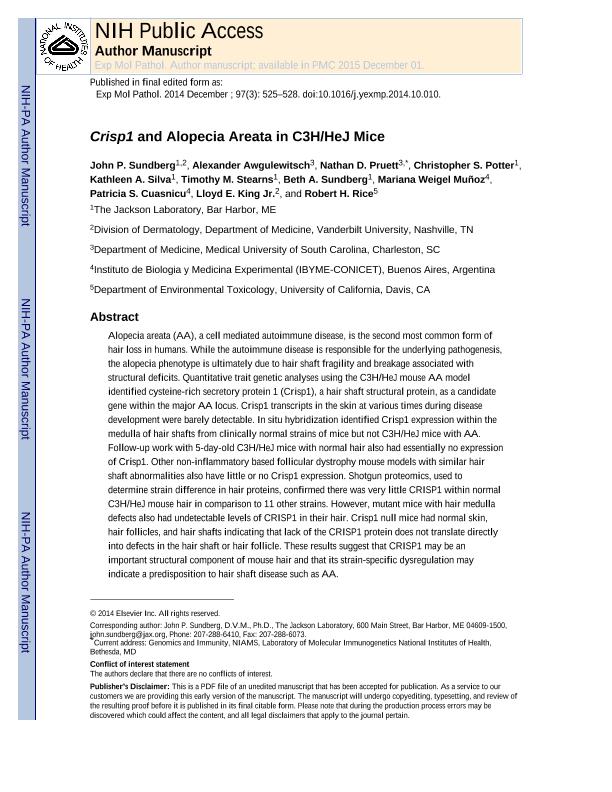Mostrar el registro sencillo del ítem
dc.contributor.author
Sundberg, John P.
dc.contributor.author
Awgulewitsch, Alejandro
dc.contributor.author
Pruett, Nathan D.
dc.contributor.author
Potter, Cristhoper S.
dc.contributor.author
Silva, Kathleen A.
dc.contributor.author
Stearns, Timothy M.
dc.contributor.author
Sundberg, Beth A.
dc.contributor.author
Weigel Muñoz, Mariana

dc.contributor.author
Cuasnicu, Patricia Sara

dc.contributor.author
King, Lloyd E. Jr
dc.contributor.author
Rice, Robert H.
dc.date.available
2017-09-25T20:06:12Z
dc.date.issued
2014-12
dc.identifier.citation
Sundberg, John P.; Awgulewitsch, Alejandro; Pruett, Nathan D.; Potter, Cristhoper S.; Silva, Kathleen A.; et al.; Crisp1 and alopecia areata in C3H/HeJ mice; Elsevier; Experimental and Molecular Pathology; 97; 3; 12-2014; 525-528
dc.identifier.issn
0014-4800
dc.identifier.uri
http://hdl.handle.net/11336/25079
dc.description.abstract
Alopecia areata (AA), a cell mediated autoimmune disease, is the second most common form of hair loss in humans. While the autoimmune disease is responsible for the underlying pathogenesis, the alopecia phenotype is ultimately due to hair shaft fragility and breakage associated with structural deficits. Quantitative trait genetic analyses using the C3H/HeJ mouse AA model identified cysteine-rich secretory protein 1 (Crisp1), a hair shaft structural protein, as a candidate gene within the major AA locus. Crisp1 transcripts in the skin at various times during disease development were barely detectable. In situ hybridization identified Crisp1 expression within the medulla of hair shafts from clinically normal strains of mice but not C3H/HeJ mice with AA. Follow-up work with 5-day-old C3H/HeJ mice with normal hair also had essentially no expression of Crisp1. Other non-inflammatory based follicular dystrophy mouse models with similar hair shaft abnormalities also have little or no Crisp1 expression. Shotgun proteomics, used to determine strain difference in hair proteins, confirmed that there was very little CRISP1 within normal C3H/HeJ mouse hair in comparison to 11 other strains. However, mutant mice with hair medulla defects also had undetectable levels of CRISP1 in their hair. Crisp1 null mice had normal skin, hair follicles, and hair shafts indicating that the lack of the CRISP1 protein does not translate directly into defects in the hair shaft or hair follicle. These results suggest that CRISP1 may be an important structural component of mouse hair and that its strain-specific dysregulation may indicate a predisposition to hair shaft disease such as AA.
dc.format
application/pdf
dc.language.iso
eng
dc.publisher
Elsevier

dc.rights
info:eu-repo/semantics/openAccess
dc.rights.uri
https://creativecommons.org/licenses/by-nc-nd/2.5/ar/
dc.subject
Gene Array
dc.subject
Hair Shaft Protein
dc.subject
Alopecia Areata Predisposition
dc.subject.classification
Bioquímica y Biología Molecular

dc.subject.classification
Ciencias Biológicas

dc.subject.classification
CIENCIAS NATURALES Y EXACTAS

dc.title
Crisp1 and alopecia areata in C3H/HeJ mice
dc.type
info:eu-repo/semantics/article
dc.type
info:ar-repo/semantics/artículo
dc.type
info:eu-repo/semantics/publishedVersion
dc.date.updated
2017-09-19T14:44:35Z
dc.identifier.eissn
1096-0945
dc.journal.volume
97
dc.journal.number
3
dc.journal.pagination
525-528
dc.journal.pais
Países Bajos

dc.journal.ciudad
Amsterdam
dc.description.fil
Fil: Sundberg, John P.. Vanderbilt University; Estados Unidos. The Jackson Laboratory; Estados Unidos
dc.description.fil
Fil: Awgulewitsch, Alejandro. Medical University of South Carolina; Estados Unidos
dc.description.fil
Fil: Pruett, Nathan D.. Medical University Of South Carolina; Estados Unidos
dc.description.fil
Fil: Potter, Cristhoper S.. The Jackson Laboratory; Estados Unidos
dc.description.fil
Fil: Silva, Kathleen A.. The Jackson Laboratory; Estados Unidos
dc.description.fil
Fil: Stearns, Timothy M.. The Jackson Laboratory; Estados Unidos
dc.description.fil
Fil: Sundberg, Beth A.. The Jackson Laboratory; Estados Unidos
dc.description.fil
Fil: Weigel Muñoz, Mariana. Consejo Nacional de Investigaciones Científicas y Técnicas. Instituto de Biología y Medicina Experimental. Fundación de Instituto de Biología y Medicina Experimental. Instituto de Biología y Medicina Experimental; Argentina
dc.description.fil
Fil: Cuasnicu, Patricia Sara. Consejo Nacional de Investigaciones Científicas y Técnicas. Instituto de Biología y Medicina Experimental. Fundación de Instituto de Biología y Medicina Experimental. Instituto de Biología y Medicina Experimental; Argentina
dc.description.fil
Fil: King, Lloyd E. Jr. Vanderbilt University; Estados Unidos
dc.description.fil
Fil: Rice, Robert H.. University of California. Department of Nutrition and Department of Environmental Toxicology; Estados Unidos
dc.journal.title
Experimental and Molecular Pathology

dc.relation.alternativeid
info:eu-repo/semantics/altIdentifier/url/http://www.sciencedirect.com/science/article/pii/S0014480014001701
dc.relation.alternativeid
info:eu-repo/semantics/altIdentifier/doi/http://dx.doi.org/10.1016/j.yexmp.2014.10.010
dc.relation.alternativeid
info:eu-repo/semantics/altIdentifier/pmid/25446841
dc.relation.alternativeid
info:eu-repo/semantics/altIdentifier/url/https://www.ncbi.nlm.nih.gov/pmc/articles/PMC4262666/
Archivos asociados
